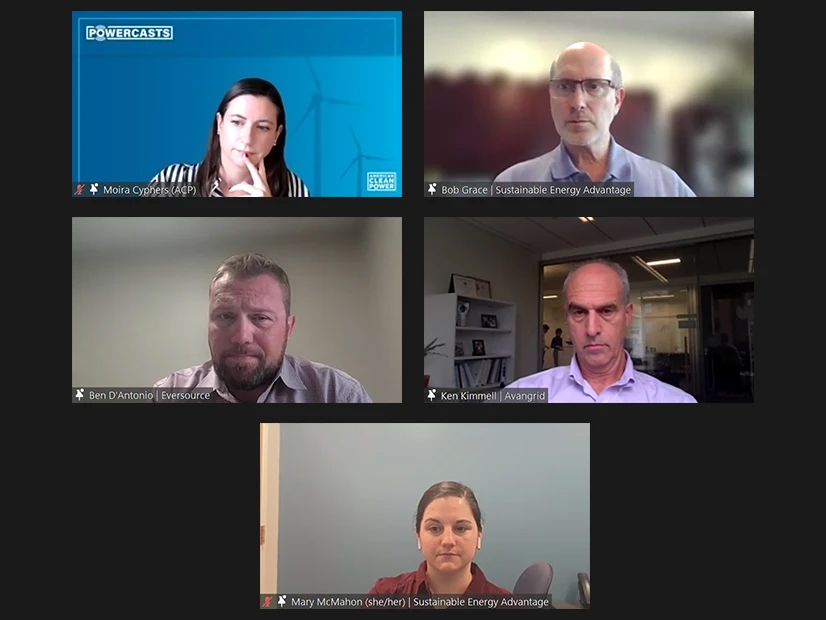
Even as the offshore wind industry continues to struggle, stakeholders’ hopes have been buoyed by the recent multistate procurement in New England, they said during a webinar held by the Northeast Energy and Commerce Association on Oct. 1.
Massachusetts selected up to 2,678 MW of offshore wind capacity in early September, while Rhode Island selected 200 MW. (See Multistate Offshore Wind Solicitation Lands 2,878 MW for Mass., RI.)
“I think Massachusetts was pretty bold in doing procurements of this size, and I think that’s going to help get offshore wind back on track,” said Ken Kimmell, chief development officer at Avangrid Renewables.
Kimmell said he is “starting to see the ship righting itself” in the wake of the price shocks that caused a wave of project cancellations in 2023.
Massachusetts and Connecticut are in talks for Connecticut to purchase the remaining 400 MW of the Vineyard Wind 2 project in exchange for Massachusetts purchasing some power from the Millstone nuclear plant, which currently is propped up by a contract with Connecticut.
The rapidly increasing costs of offshore wind have caused some trepidation from New England lawmakers; the 2,678 MW selected in the multistate procurement fell significantly short of the 6,000 MW initially sought by the three states.
While the prices for the procurement will not be announced until the contracts are filed with state utility regulators, the cost of offshore wind per megawatt-hour has roughly doubled in just a few years.
“The last couple years have been hard for the offshore wind industry … but I think the future is bright,” said Moira Cyphers, director of Atlantic offshore and eastern state affairs at the American Clean Power Association. “This is a resource that we absolutely have to have. The climate goals and the reliability goals don’t happen without offshore wind.”
Despite the current cost pressures, Cyphers said procuring projects at scale “is really what’s going to bring down costs over time.”
Cyphers added that the first line of projects will shoulder costs associated with building up the domestic supply infrastructure, ports and shipping capabilities, which “future projects will then build on.”
Kimmell echoed the need to improve the domestic supply chain and added that increasing global demand for offshore wind has exacerbated the recent cost increases.
“Supply and demand are out of whack,” Kimmell said. “We are at a real disadvantage relying so much on European suppliers.”
Kimmell also voiced his support for longer contracts for offshore wind resources.
“It [would] reduce prices to ratepayers if Massachusetts were to extend the length of contracts,” Kimmell said, noting that the current generation of turbines will last “quite a bit longer than 20 years.”
Cyphers said more flexibility regarding economic adjustment mechanisms could help improve future solicitations.
“I think flexibility is going to become a lot more important at this stage in development,” Cyphers said, noting that Connecticut, Massachusetts and Rhode Island each took slightly different approaches to the inflation indexation options they gave to developers. Ultimately, no indexed project bids were selected.
“I think to the extent that we can work to identify other ways to introduce flexibility, and make sure these procurements become more standardized, we’ll see more success in the future,” Cyphers said.
Ben D’Antonio, manager of transmission strategy and economic analysis for Eversource Energy, stressed the need to develop transmission solutions to add “certainty and clarity” to the process of interconnecting offshore wind projects.
He expressed hope that state-level efforts to reform permitting and siting procedures, coupled with FERC’s new interconnection requirements, eventually will help to speed up development timelines, which currently take about a decade for offshore wind projects.
While developers have limited insight on where the best places to interconnect are, D’Antonio advocated for a more proactive transmission development approach. He floated the idea of charging a fixed fee for projects to interconnect so developers could “know ahead of time what it’s going to cost to interconnect.”
“We want to try out this ‘build it and they will come’ approach,” D’Antonio added. “There’s no transition without transmission.”
This year, FERC approved a proposal from ISO-NE and the New England states that would enable the states to make transmission investments to meet long-term needs, including needs associated with new offshore wind generation. (See FERC Approves New Pathway for New England Transmission Projects.) The six New England states also recently won a $389 million Department of Energy grant that largely will be dedicated to building substations to connect offshore wind to the grid. (See DOE Announces $2.2B in Grid Resilience, Innovation Awards.)
Kimmell echoed D’Antonio’s comments about the need for proactive transmission planning, saying a line-by-line approach to transmission solutions makes sense for the initial projects coming online, but not for the next wave.
“We certainly embrace the idea of shared transmission and planned transmission,” Kimmell said, advocating for the socialization of some of the costs associated with building transmission for offshore wind.
